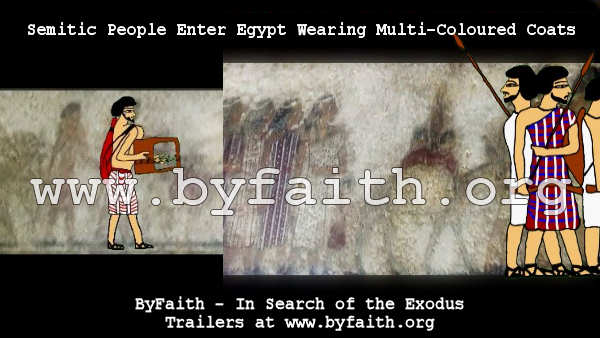
|
|
The Hebrew Slaves In Egypt and the Hyksos in Avaris
Have the Hebrew slaves been found painted in a tomb from ancient Egypt?
In a tomb at Beni Hassan in Egypt a scene is found of a migration of Semitic people entering into Egypt – women, children, animals and a man with
a hand-held instrument, like the one David played before the Ark of the Covenant.
These Semitic people are clearly different from the depictions of the Egyptians all around them, for they have fairer skin, sharper features and the men have pointed beards. These depictions date to the time of Joseph and those characterised are wearing multi-coloured coats. This painting acts as an interesting confirmation of the description that the Bible gives us of Joseph and his family. In addition, in the Bible's Land of Goshen, excavations have revealed a Semitic city called Avaris. Avaris was a huge city and the foundations of many structures have been found. The Semitic people who lived here became powerful and their leaders ruled vast areas of land and to the amazement of many, several royal seals were also found here bearing a name from the Bible – Jacob. The Bible says, ‘Therefore they set taskmasters over them to afflict them with their burdens, and they built for Pharaoh supply cities, Pithom and Raamses’ Exodus 1:11. The cities of Avaris and Ramesses were found in the same area of the Bible's land of Goshen. In Avaris they also found houses that were of the same design later found in Israel. The people who lived in Avaris were a Semitic people called the Hyksos and they left Egypt in one mass Exodus, being expelled by Pharaoh Ahmose. Some people believe that the Hyksos are the Hebrew slaves, stating all the similarities and noting that after they left Egypt, they disappeared from history. Whilst others think that the Hebrews lived amongst the Hyksos and it was their departure that explains the beginning of the fierce persecution of the Hebrews by the Egyptians. So the Egyptians made the children of Israel serve with rigor and they made their lives bitter with hard bondage – in mortar, in brick and in all manner of service in the field. Exodus 1:13-14. In ancient Thebes, Egypt, there is a tomb where Semitic slaves are depicted. In Rekhmire's Tomb, several Semitic men are shown in service. In the text they are identified as ‘captives’. One scene shows a Semitic man making bricks and overseeing these men is a tall Egyptian and the text says, “The rod is in my hand, be not idle.” In the Bible the children of Israel are beaten for not fulfilling their quotas and they are told, "You are idle." ‘Israel in Egypt - The Exodus Mystery DVD’ Enter ancient Egypt and search for the evidence for the Bible's Exodus. Go. ‘The Exodus Evidence Book’ Experience a photographic search for the Bible’s Exodus. 100+ colour photos. Go. |
More From ByFaith The Trinity Go Ancient Egypt Go The economy Go The face of Joseph Go Signs of maturity Go Why can't I sleep? Go Christian or disciple? Go In pursuit of purpose Go 150 Years of Revival Go What is my worldview? Go Do you have a dream? Go Understanding revival Go A sense of abandonment Go Where was the Red Sea? Go The battle of the mind Go Forgiveness and justice Go Great revivals in Korea! Go Economise to evangelise Go How can we see revival? Go Great Christian Revivals Go I want to be a missionary! Go Three simple godly habits Go What really is repentance? Go The Hebrew Slaves In Egypt Go Who was the Exodus Pharaoh? Go Revival Fires and Awakenings Go Discover a greater anointing Go Mission Preparation Training Go What's wrong with witchcraft? Go Ancient Israel found in Egypt Go The face of the Exodus Pharaoh Go I need £500 for a mission trip Go Is Mount Sinai in Saudi Arabia? Go Revival and the Great Commission Go The Cross and the Blood of Jesus Go The lost years of Moses in Egypt Go Divine principles and human logic Go Christian charity and abuse of it Go The spirit of fear and intimidation Go One thing I have desired of the Lord Go The forgotten legacy of Christianity Go The priesthood, the urim and thummim Go Should Christians date non-Christians? Go Why should I keep re-reading the Bible? Go Is there evidence for Joseph in Egypt? Go Are short-term mission trips effective? Go How Christianity made the modern world Go Christian revival will be controversial! Go |

|

